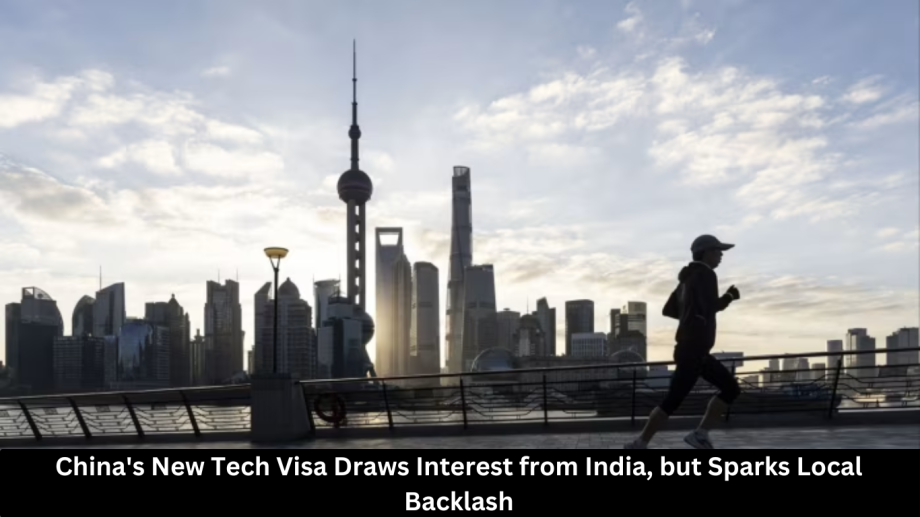China has launched a new tech visa initiative aimed at attracting global talent, particularly from nations with a deep reservoir of technology professionals like India.
- What Is China’s New Tech Visa Program?
- Why Indian Tech Professionals Are Interested
- Local Backlash in China: Rising Concerns
- Government’s Response to the Backlash
- How This Impacts India-China Relations
- Comparison with Other Countries’ Tech Visas
- What Should Indian Tech Professionals Consider?
- How India Should Respond
- Frequently Asked Question
- What is China’s new tech visa program?
- Why are Indian tech professionals interested in moving to China?
- What are the main concerns among Chinese citizens about this visa?
- How does China’s tech visa compare to similar visas in other countries?
- Can this visa lead to permanent residency in China?
- What should Indian professionals consider before moving to China on a tech visa?
- How might this affect India’s tech industry and talent pool?
- Conclusion
While this move signals Beijing’s growing ambition to compete globally in advanced technologies such as artificial intelligence, semiconductors, and quantum computing, it is also creating tensions within China’s local workforce.
Indian tech professionals are showing increased interest in this opportunity, but many Chinese citizens are voicing concerns over job competition, wage suppression, and cultural integration issues.
More Read: Taiwan Rejects U.S. ’50-50′ Chip Production Proposal, Prioritizes Tariff Talks in Trade Discussions
What Is China’s New Tech Visa Program?
China’s new tech visa, also referred to in some circles as the “Talent Introduction Visa,” is part of a broader national strategy to become a global leader in high-tech innovation by 2035.
The visa is designed to fast-track entry for foreign professionals in STEM fields — science, technology, engineering, and mathematics.
Key Features of the Tech Visa:
-
Eligibility: Highly skilled professionals in areas like AI, cybersecurity, blockchain, robotics, and biotech.
-
Duration: Up to 5 years with renewal options.
-
Path to Residency: The visa may serve as a stepping stone to permanent residency or long-term work permits.
-
Incentives: Tax benefits, housing allowances, access to top-tier research institutions, and in some cities, subsidies for family relocation.
This move aligns with the country’s 14th Five-Year Plan, which emphasizes technological self-reliance, especially in light of increasing trade tensions and restrictions with the West.
Why Indian Tech Professionals Are Interested
India is home to one of the largest and fastest-growing pools of tech talent globally. From IT services and software development to advanced research in AI and machine learning, Indian professionals have earned a global reputation.
Several factors are drawing Indian techies toward China:
-
Higher Salaries & Better Infrastructure
Although India has a vast number of tech workers, wage stagnation and infrastructure limitations make offers from Chinese firms more attractive. -
Limited H-1B and Western Visa Opportunities
As Western countries tighten immigration policies and cap visas, China is emerging as an alternative destination. -
Growing Presence of Indian Companies in China
Indian tech companies like Infosys, TCS, and Wipro already operate in China. These existing ecosystems make relocation easier for Indian professionals. -
Access to Frontier Technologies
China is heavily investing in frontier technologies like quantum computing, 6G, and AI, providing opportunities to work on world-leading projects.
Quote from Indian Software Engineer:
“Working in China means faster career growth, higher salaries, and exposure to technologies that are still emerging in India,” says Rohit Mehra, a Bengaluru-based software architect exploring opportunities in Shenzhen.
Local Backlash in China: Rising Concerns
While the new visa scheme is a welcome sign for international talent, many in China’s domestic workforce are pushing back against the move.
Main Concerns Among Chinese Citizens:
-
Job Displacement
Many fear that an influx of foreign professionals, especially in cities like Shanghai, Beijing, and Shenzhen, could lead to fewer opportunities for local graduates. -
Wage Suppression
Increased competition in the job market may lead to stagnating or even declining wages for Chinese workers, particularly in mid-level tech roles. -
Cultural and Language Barriers
Integrating foreign workers into teams can be challenging in a country where English fluency isn’t widespread. -
Nationalism and Security Fears
Some segments of the population are worried about foreign access to sensitive data and core technologies, particularly in sectors that have strategic importance.
Social Media Sentiment:
On Chinese platforms like Weibo and Zhihu, reactions have been mixed. While some support the idea of global collaboration, others criticize the government for “importing competition.”
“Why do we spend years educating our engineers just to hand over their jobs to foreigners?” — anonymous Zhihu user
Government’s Response to the Backlash
In response to rising domestic concerns, Chinese authorities have taken steps to assure locals that the new visa program will not jeopardize local employment. Some of the countermeasures and policies include:
-
Quota Systems: Companies must hire a minimum percentage of Chinese nationals before hiring foreigners.
-
Local Upskilling Initiatives: The government is investing in programs to upskill the local workforce in advanced technologies.
-
Public Communication Campaigns: To improve sentiment, state media has been promoting the benefits of knowledge exchange and the long-term gains of international cooperation.
How This Impacts India-China Relations
The tech visa could open a new, albeit complex, chapter in India-China relations. Despite their geopolitical tensions — including border disputes and digital bans — economic interdependence in the tech sector appears to be growing.
Strategic Implications:
-
Softening of Tech Nationalism: This visa might be a sign that China is open to cooperation in select areas, even with competitors like India.
-
Boost in Bilateral Trade in Services: If more Indian professionals work in China, cross-border business collaboration in tech services could increase.
-
Brain Drain Risk for India: Critics in India argue that this could worsen the already existing brain drain in critical sectors like AI and cybersecurity.
“We risk losing our top minds to countries that are more aggressive in talent acquisition. India must respond with its own policies to retain tech talent,” says Dr. Kavita Sharma, a policy analyst at ORF India.
Comparison with Other Countries’ Tech Visas
China’s tech visa is entering a competitive global landscape. Here’s how it stacks up:
| Country | Visa Type | Key Features |
|---|---|---|
| USA | H-1B | Highly competitive, lottery-based, employer-sponsored |
| Canada | Global Talent Stream | Fast-track visa, family relocation, PR pathways |
| Germany | Blue Card | High-skill EU visa, easier for STEM professionals |
| China | Tech Talent Visa | Long-term visa, tax incentives, national project access |
China’s tech visa stands out in terms of project involvement (e.g., working on government-prioritized AI initiatives), but language and cultural barriers remain a significant challenge compared to English-speaking countries.
What Should Indian Tech Professionals Consider?
While the new visa presents exciting opportunities, it also comes with challenges that Indian professionals must prepare for:
Pros:
-
Competitive compensation
-
Cutting-edge tech exposure
-
Global career development
-
Lower competition compared to U.S. or EU markets
Cons:
-
Language and cultural adaptation
-
Political and regulatory unpredictability
-
Limited freedom of expression or internet access
-
Social integration challenges
Tips Before Moving:
-
Learn basic Mandarin and Chinese work culture norms.
-
Consult with expats already living in China.
-
Understand visa legalities and contractual obligations.
-
Prepare for differences in work-life balance (China is known for the “996” work culture — 9am to 9pm, six days a week).
How India Should Respond
The interest of Indian professionals in China’s visa is a wake-up call for India’s policy-makers. To prevent brain drain and remain competitive:
Policy Suggestions:
-
Create a National Tech Talent Visa: India can attract foreign talent and retain its own by easing visa rules for high-skilled professionals.
-
Public-Private Partnerships: Incentivize Indian companies to invest in cutting-edge R&D and offer global exposure to local talent.
-
Educational Reform: Upskill students and early-career professionals in AI, blockchain, and other future-facing technologies.
Frequently Asked Question
What is China’s new tech visa program?
China’s new tech visa, often called the “Talent Introduction Visa,” is designed to attract highly skilled foreign professionals in science, technology, engineering, and mathematics (STEM) fields. It offers long-term work authorization (up to 5 years), potential residency pathways, tax incentives, and access to high-priority national tech projects.
Why are Indian tech professionals interested in moving to China?
Indian professionals are drawn by higher salaries, exposure to cutting-edge technologies like AI and quantum computing, better infrastructure, and limited opportunities in the West due to tightening immigration policies. Chinese companies and government-backed projects offer growth opportunities for experienced talent.
What are the main concerns among Chinese citizens about this visa?
Local backlash stems from fears of job displacement, wage suppression, increased job competition, cultural integration issues, and concerns over national security. Some Chinese citizens worry that hiring foreign talent may come at the expense of local job seekers.
How does China’s tech visa compare to similar visas in other countries?
Compared to visas like the U.S. H-1B or Canada’s Global Talent Stream, China’s tech visa offers long durations and access to national innovation projects but has challenges like language barriers, strict internet censorship, and a less familiar work culture for foreigners.
Can this visa lead to permanent residency in China?
Yes, in many cases, especially for highly skilled professionals, the tech visa can serve as a stepping stone to long-term residency or even a Chinese green card, though the process is more selective than in Western countries.
What should Indian professionals consider before moving to China on a tech visa?
Key considerations include:
- Language and cultural differences
- Work culture (e.g., long hours)
- Political climate and internet restrictions
- Visa terms and company reliability
- Cost of living in cities like Beijing or Shenzhen
How might this affect India’s tech industry and talent pool?
The visa could accelerate brain drain from India if top talent relocates to China. It highlights the need for India to improve its own incentives, infrastructure, and career opportunities in tech to retain skilled professionals and remain globally competitive.
Conclusion
China’s new tech visa initiative is both a strategic move to boost innovation and a diplomatic test case in balancing domestic sentiment with global ambition.
While India’s tech community is understandably intrigued by the professional opportunities, the reaction within China underscores the social and political complexities of global talent migration.
In the long run, both nations will need to innovate—not just in technology, but in policy and human capital strategy—to maintain their competitive edge. The tech visa is more than just a bureaucratic change; it’s a symbol of the shifting dynamics in the global tech race.








